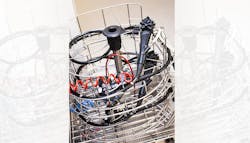Pre-treating short cuts, task shifts can breed danger for patients
Delaying or even skipping out on the pre-treatment of used surgical devices and instruments – endoscopic or otherwise – creates serious problems for Sterile Processing & Distribution professionals and can lead to dangerous problems for patient outcomes.
“When pre-cleaning is not performed, the likelihood for biofilm formation increases due to the prolonged time afforded for bacteria to adhere to the device itself,” said J. Hudson Garrett Jr., PhD, MSN, MPH, MBA, FNP-BC, CPHQ, PLNC, AS-BC, IP-BC, VA-BC, CFER, CPPS, CDONA, DICO-C, GDCN, NREMT, NCEE, FACDONA, TR-C, FAAPM, FNAP, FSHEA, Adjunct Assistant Professor, Division of Infectious Diseases, Department of Medicine, Center for Education and Training in Infection Prevention, University of Louisville School of Medicine. “Skipping this step altogether can tremendously endanger the overall efficacy of high-level disinfection of the device.”
Ron Banach, Director of Clinical Education, Ruhof Inc., is more direct: “Once the biofilm process has started, the ability to attain high-level disinfection or sterilization will fail.”
If there are any questions about pre-treatment or the delay or lack thereof, Jamie Zarembinski CCSVP, CER, Clinical Educator – Sterile Processing, Key Surgical, a STERIS company, synopsizes the inevitable outcome. “Patient harm. There is no way around it. An improperly reprocessed scope is a hazard for the patient,” she warned. “Taking shortcuts, skipping steps in the reprocessing cycle, and not following the instructions for use (IFU) ultimately leads to patient harm. There is significant pressure in this role to get things done quickly. This pressure is often coupled with inadequate training and insufficient continuing education opportunities. Endoscopes are incredibly complex and should be reprocessed with great care and attention to detail. These devices are required to come with detailed IFUs for the manufacturer to obtain 510(k) clearance. The IFU must contain reprocessing instructions. By referencing the IFU for each device, providing adequate training and continuing education, and keeping IFUs accessible, facilities can reduce errors and the risk of patient harm related to neglecting steps in the reprocessing cycle.”
Zarembinski’s colleague on the OR side agrees wholeheartedly.
“It is vital to remember that the patient on the operating room table is all our patient, and we are dealing with their life,” indicated Michelle Lemmons RN, PHN, CNOR, CCSVP, Clinical Educator – Operating Room, Key Surgical, a STERIS company. “There is no shortcut that is worth putting a person’s well-being and life at risk. The ‘do more, with less, in less time’ cycle can be challenging to overcome. However, keeping the patient front of mind is the solution to breaking this cycle. As Jamie stated, endoscope reprocessing is complex and attention to detail is imperative. The scope reprocessing role should be considered as specialty, and the training and preparation for this role should reflect that. Remember that the 2008 HICPAC Guidelines stated, “contaminated endoscopes have been linked to more healthcare-associated infections than any other medical device.” Prioritizing this specialty through training and education is a great investment for any facility.”
Cornerstone of quality
[Pre-treating] is critical to ensure subsequent reprocessing steps, including high-level disinfection or sterilization, can be effective, according to Melinda “Mindy” Benedict, MS, CIC, CFER, Global Senior Manager, Infection Prevention, Olympus Corporation of the Americas.
“When performed correctly and with knowledge as to why the process is critical, [pre-treating] is a cornerstone in high quality safe patient care,” she noted. “[Pre-treating] requires minimal time to complete and provides the foundation for effective and efficient reprocessing of medical devices.”
The absence of pre-treatment at the point of use, interrupts the linear progression of the entire process, according to David Willoughby, Vice President, Marketing & Business Development, Medtrica.
“Simply put, failure to conduct [pre-treating] on post-procedure instruments can significantly complicate the manual cleaning/decontamination process, which in turn increases the risk of patient morbidity and patient cross-contamination,” Willoughby said. “It is well understood that the longer bio-contaminants are left on instruments the harder they are to remove. Microbes can easily damage instruments if they remain on instrumentation surfaces (internal and external) for prolonged periods of time, making the removal of these encrustations and biofilms extremely challenging, if not impossible, to address through standard cleaning procedures. This in turn creates a cascade of problems and circumvents the very procedures so rigidly adhered to by SPD.
“So, in essence, POU [pre-treating] really comes down to effectively adhering to and applying pre-transport protocols with the most effective enzymatic and detergent-based [pre-treating] and wetting agents (formulations) available in order to not only prevent instrument damage and or malfunction but also (and more importantly) to mitigate the risk of surgical site infection,” he added.
John Whelan, RN, Clinical Education Specialist, Healthmark Industries, cautions that OR and SPD professionals should not short-change pre-treatment but also should recognize additional necessary steps in that early process. This includes disconnecting accessories, preparing handoff communication, and preparation for soiled transport, he added.
Where and when this occurs matters for six key reasons, according to Whelan.
- “It’s in endoscope manufacturer’s IFUs to perform point-of-use treatment as soon as the procedure is complete. IFUs always need to be followed.
- “It’s consistently found in national standards and guidelines – endoscopes need to undergo [pre-treating] at point of use. Standards and guidelines direct best practices.
- “For certain brand, generation and type of endoscopes, there are steps that can only occur at the point of use – while the scope is still hooked up to the processor. For example, certain GI endoscopes require flushing the air water channel with the air water channel cleaning adapter. This can only happen while the scope is connected to the airflow regulator in the procedure room – so it can’t be done in the reprocessing room.
- “The rationale here is critical to understand the significance. The sooner the better to remove residual bioburden and limit biofilm development. It only takes minutes for biofilm to form and proliferate.
- “Each step of processing done correctly and completely allows the steps that follow to be more successful.
- “Each step performed correctly and completely serves to limit chances for patient injury/infection.”
Simple math
OR and SPD professionals merely need to equate the pre-treatment process as a mathematical equation, according to Melissa Kubach, Clinical Education and Training Manager, National Solutions Team, Agiliti.
“Each flexible endoscope cleaning step serves a purpose necessary for achieving the desired outcome – a patient-safe device,” Kubach said. “[Pre-treating] is the first step in an extensive line of steps. Skipping any one step places all subsequent cleaning actions at a disadvantage.
“Mathematically speaking, each stage of cleaning equates to reducing bacteria,” she continued. “Every stage, from [pre-treating] to scrubbing to flushing to rinsing, is only able to achieve a certain level of logarithmic bacteria reduction. Even with repetitious cleaning, there will be a point for which no additional benefit will be realized. This is even more concerning when employing high-level disinfection; a method that does not remove or kill all living microorganisms.
“Delayed cleaning allows bacteria to multiply at exponential rates. Consequently, as bioburden is allowed to increase, the proportionate ability to produce a thoroughly clean final product has decreased. Additionally, biofilms can form as bacteria adhere to internal channels, making removal increasingly difficult or even impossible - and which places patients at even greater risk of infection,” Kubach noted.
Shaun Sweeney, Vice President, Cygnus Medical, encourages the OR and SPD to set priorities.
“Unfortunately, unlike with flexible endoscopes many ORs have not prioritized [pre-treating] as a critical step,” he observed. “The more intricate the instrument the more chances of gross contamination drying in crevices and not being properly removed in the wash cycle. Like eggs on a plate, they are easily removed with water immediately after the case. With added time they are proportionately harder to remove. The quality of patient care for the next patient and the overall condition of the instrument inventory are at risk.”
Because flexible endoscopes represent some of the most complex instruments to clean, processing errors have resulted in serious patient harm and death, which has been well-document in media reports and professional studies, according to Gregg Agoston, M.B.A., Vice President, Business Development, SPD Transformation Services, SpecialtyCare.
“The American College of Surgeons identified two risk factors for [surgical site infections] that specifically pertain to Sterile Processing,” Agoston said. “First, the longer a patient is exposed to the OR the greater the risk of SSI. Second, the instruments must be sterile or high-level disinfected. The level of processing is dependent upon the IFU/Spalding Classification. Instrument processors can impact the length of OR exposure if the instrument is not available or if an instrument is delivered to the OR that is not in good working condition. In addition, if an instrument is not clean it cannot be considered sterile and could lead to an SSI. While there are many risk factors that contribute to an SSI – some intrinsic to the patient (e.g., smoking, diabetes, etc.) and other extrinsic (e.g., patient preps, sterile technique, use of antibiotics etc.), instrument processing does play a significant role in the prevention of SSI by ensuring that products they are responsible for do not extend patient exposure in the OR and by ensuring that instruments are in fact sterile or high-level disinfected.”
Jean Sargent, Principal, Sargent Healthcare Strategies, has extensive experience as a hospital Supply Chain and SPD leader, and highlights the butterfly effect.
“The delay in completing the complex cleaning process of over 100 steps will likely create delays in turnaround-times, and possibly cause damage, further delaying the time to have the scope ready for the next patient. Delay in patient treatment or cancellation of treatment is an issue in the satisfaction scores,” she said.
Editor’s Note: Due to a recent industry lexicon change, all references to “pre-cleaning” have been changed to “pre-treating” or “pre-treatment.”
Continue reading …
Pre-treatment at point-of-use ‘whodunit’
Pre-treating short cuts, task shifts can breed danger for patients
What does SPD need for endoscope reprocessing quality
All hail to the hybrids by the mid-2030s
Don’t let hang-time become a hang-up
Quality sterile processing a step-by-step process that starts in surgery

Rick Dana Barlow | Senior Editor
Rick Dana Barlow is Senior Editor for Healthcare Purchasing News, an Endeavor Business Media publication. He can be reached at [email protected].





